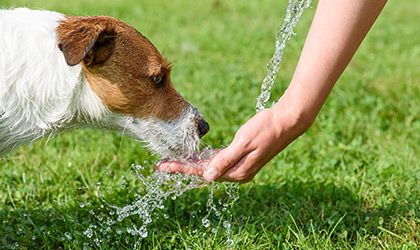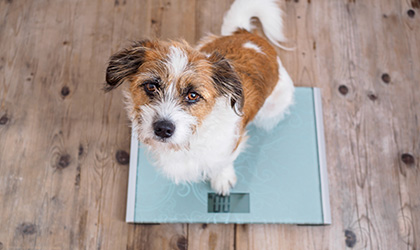
We exercise to look good, feel great and maintain a healthy lifestyle. And it’s no different for our pets. You could even say our furry friends are built for physical activity – just look at your dog’s muscular physique or cat’s agile figure. Exercise isn’t only a sure-fire way to keep your little fur balls in shape; it’s vital for mental stimulation and emotional wellbeing too. In essence, it’s a cornerstone of their overall health and happiness, and shouldn’t be neglected. Of course, there’s no ‘one-size-fits-all’ activity regimen for all domestic animals – you always need to take lifestyle, breed, age and weight into account when establishing an activity routine. So, with that in mind, here’s everything you need to know about exercising your furry companions.
Dogs
There’s much truth in the old adage, ‘a tired dog is a good dog’. Daily exercise is vitally important for your canine’s physical health and mental wellbeing, while also helping to reduce unwanted behaviours born from anxiety or boredom. Exercising your dog implies activities that extend beyond the remit of your home or garden. After all, your furry friend loves a good ol’ sniff, explore and opportunity to be, well, a dog! But how much exercise does your pooch really need? (Psst…always consult your vet before embarking on a rigorous activity programme).
Puppies
Though puppies are full of vitality and energy, they tire quickly, so don’t need as much physical activity as their adult counterparts. Generally, puppies require several short bursts of exercise throughout the day, around 5-10 minutes per session. Exercise can be as simple as ‘playing’ – and the more time you spend with your pup, the quicker you’ll learn to read his body language and gauge when he’s ready for a break. Don’t forget, long walks are taxing on your little one’s growing bones and joints; if you want to establish a walking routine, always start gradually. Top tip: walk five minutes for every month of puppy’s life, up to twice per day – for instance, a 4 month old pup could walk for 20 minutes in the morning and evening.
Adult
While you need to consider ‘age’ and ‘health’ when establishing an exercise regimen for your dog, ‘breed’ is the most useful indication of activity levels. Generally, sporting or herding breeds (Terriers, Retrievers, Pointers, Scent hounds and Shepherds) need around 60-90 minutes of physical activity per day, such as hiking, running and powerwalking. On the other hand, adult toy or low-energy breeds (Maltese, Yorkies, Chihuahuas, Great Danes, Mastiffs, Newfoundland, Pugs, French Bulldogs and Shih Tzus) require much less exercise – anywhere between 30 and 60 minutes a day. A slow stroll around the block, or even a game of fetch in the park will suffice. Any form of physical activity needs to take ability, age and health into account too, regardless of breed.
Senior
As your lovable mutt ages, he won’t be sprightly or energetic as he once was. His joints may become stiff, and he could tire quicker. That said exercise – albeit gentle activity – still needs to be an integral part of your dog’s daily routine. Old pooches require around 30-60 minutes of exercise each day, and this is normally divided into two or more activity sessions. For most dogs, this will mean continuing with walks, but for those with joint issues, you could try swimming.
Cats
Although felines are blessed with the evolutionary privilege of a fast metabolism, they still need exercise. Unlike their canine counterparts, you can’t hitch cats to a lead and take them for a casual walk around the block (well, you could, but it would take a lot of training!) Yet, with a little imagination, you can encourage kitty to be more active.
Kittens
Like puppies, kittens are bright-eyed, bushy-tailed and full of energy. Short-lived playing sessions of 5-10 minutes throughout the day are usually the best ways to engage kitty – and that’s where the value of toys and makeshift props come in. Kittens aren’t fussy creatures (yet!), so you don’t need to splash out on fancy toys. A ball of kitchen foil, a shoelace or a paper wand will do the trick. Providing your little fur ball with a means to climb and hide is another resourceful way to get him moving. Cat trees or towers are great investments, and will entertain your furry friend for hours on end.
Adults
Although adult cats are in their prime, some may be a little harder to engage and coax into exercising. Indoors cats are susceptible to packing on the pounds, so inspiring them to move is even more pressing. Thankfully, there are many ways to spark your feline’s playful spirit and achieve the recommended 30 minutes of moderate exercise per day. You could train your cat to perform tricks for low-calories rewards; encourage him to chase feathers, balls, toys or flashlight pointer (be careful not to shine this in your cat’s eyes); or leave tissue paper, cardboard boxes or paper bags to motivate him to play. Catnip is another excellent way to stimulate your little fur ball to pounce, jump and run to his daily exercise quota. Remember, always choose toys and props carefully – avoid those with any small pieces your four-pawed companion could swallow.
Seniors
It can be tempting to let your older cat snooze and lounge about all day, but physical activity is still vitally important for their sense of wellbeing. Though senior cats won’t usually have the interest or endurance for extended play, they can still manage and profit from shorter activities. Start with play sessions that only last a couple of minutes. And try choosing an activity that exploits your cat’s predatory nature – one that encourages them to pounce, jump and dart. Once you’ve found something your feline enjoys, experiment with different variations and props, as well as increasing the amount of time you spend playing with him.
Take home message
Exercising your furry friends safeguards their health, happiness and longevity – ultimately, it’s a cornerstone of their overall wellbeing and shouldn’t be compromised. You see, the benefits of physical activity are tremendously far-reaching for your pet: it supports weight loss, joint health, digestive issues and can even control behavioural problems. Remember, there’s no ‘one-size-fits-all’ exercise regimen for your four-pawed companions. Always take breed, age and health into account when establishing an activity programme. Oh, and don’t be shy to consult your vet if you have any questions either.
References:
-
PDSA. (2018). How much exercise does my dog need? Available online: https://www.pdsa.org.uk/taking-care-of-your-pet/looking-after-your-pet/puppies-dogs/how-much-exercise-does-your-dog-need
-
Pets 4 Homes. (2018). How much exercise does your dog need? Available online: https://www.pets4homes.co.uk/pet-advice/how-much-exercise-does-your-dog-need.html
-
Pets 4 Homes. (2018). How to exercise your cat? Available online: https://www.pets4homes.co.uk/pet-advice/how-to-exercise-your-cat.html



